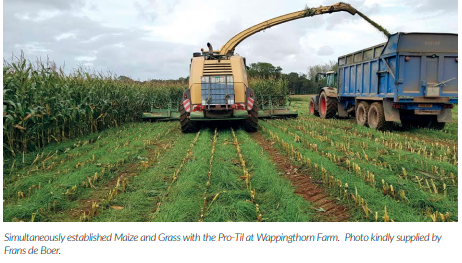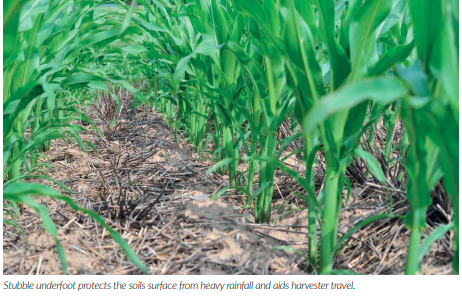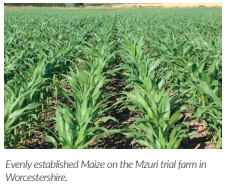MZURI, MAIZE AND MANAGING SOILS

Mzuri’s trial farm manager and knowledge exchange officer, Ben Knight highlights the benefits of the Mzuri system for establishing profitable Maize crops this Spring.
Through regular contact with Mzuri users around the country and conducting our own trials, I have seen first-hand how the Mzuri system can reap benefits for Maize establishment.

Under sowing and drilling into cover
By far the most relevant and up and coming aspect of successful Maize production that the Mzuri system is well placed to deliver surrounds under sowing or planting into cover. Many of our growers are achieving excellent results either through seeding Maize and grass down alternating legs of the Pro-Til or by drilling directly into already established grass leys or stubbles.

I wholeheartedly believe that growing Maize with some sort of continuous groundcover will become a mandatory regulation in the near future in a bid to protect our soils from the huge amounts of run off and erosion we so commonly associate with Maize. Not only that but a growing crop underfoot can mean the difference between a harvested crop in the clamp or not being able to get in the field with the harvester in the first place (let alone getting it out again) – a sight that was all too common last year. A grass based Maize system can provide businesses with additional grazing or another cut of silage from the grass crop, pre or post Maize. In a time where bottom lines are increasingly under pressure, this could provide a helpful alternative income for land that would previously be nothing more than a post-harvest mud bath, requiring extensive remedial action. The green cover will also mop up residual Nitrogen, making the most out of the applied products and returning it to the soil in a stable state.

I have no problem in advocating the use of dual cropping in a Maize situation and have seen first-hand how the network of roots stabilise the soil long after the Maize crop has senesced. When we’re being faced with huge amounts of rainfall, a growing cover can give us the protection we need to keep our soils in the field where they belong.
Band placed fertiliser for better phosphate uptake
With the popular dual tank Pro-Til models, growers can apply DAP or another product of their choice below the seed via the front leg at the time of drilling. It’s commonly known that Phosphate is very immobile in the soil, so by placing the fertiliser under the seed for the seminal root to access, the young crop benefits from guaranteed nutrient availability which is important for good plant development. I have seen this replicated numerous times across trials where Maize has been established with and without band placed fertiliser. It was clear throughout the life of the crop what positive effects early nutrition (or the lack of) had on factors such as cob maturity. By placing this fertiliser in a targeted band, it limits the availability of nutrients for weeds which helps to reduce competition and gives Maize the best possible start. It also has the added advantage of reducing the need for an additional pass which saves both time and money.
Accurate spacing, even around corners
There’s no doubt I’m a proponent for the Mzuri strip tillage system, but it’s when planting Maize that the Pro-Til’s independent pivoting coulters really come in to their own. By following the direction of travel of the drill, even around tight headland corners, seed is placed accurately into the centre of the tilled nursery zone. The level of uniformity across the field ensures row spacings and seed depth are consistent and coupled with the Xzact seed singulation units, plants are evenly spaced apart, maximising the light interception to be converted into yield.
As the founding fathers of strip tillage, North America have conducted many trials which highlighted the importance of seeding in the centre of the tilled zone. It’s been well noted that seeds placed outside or on the peripherals of the tilled strip don’t perform as well as those that are accurately drilled and go on to have a negative effect on the overall performance of the field.

Lock up carbon and protect our soil structure
I’m delighted that soil health and carbon sequestration are finally getting the mainstream ‘airtime’ that they deserve. It’s been long overdue but with discussion around the future of red diesel prices and the need for more sustainable farming there has never been a better time to look at the best way to utilise soil as our most precious asset.

The Mzuri system revolves around dense surface residue which I encourage Mzuri users to drill direct into, to preserve moisture, protect against wind and water erosion, and build organic matter supporting soil microbiology. Moving away from heavy cultivations, many direct drills simply can’t cope with the levels of surface residue that we need to improve our soils and sequester sufficient carbon. In a Maize situation, arguably drilling direct into a grass ley provides little volume to drill into but as part of a wider rotation, the Mzuri Pro-Til is equally at home drilling into standing cover crops and thick chopped straw. Good soil structure is certainly something you can’t achieve overnight, but by fostering a long term, rotational view many users find that where they once sank to plough depth, their soils are better able to carry harvesting equipment and their ditches run clear.
Preserving moisture for quick establishment
Drilling direct into stubbles, grass leys or even organic fertilisers will preserve moisture at the time of drilling which promotes quick and even establishment. I’ve seen countless occasions where Mzuri strip till Maize suffered less bird damage than its conventional neighbours due to its timely and all together approach to emergence! Preserving this moisture also has lifelong effects for the Maize crop, where it isn’t uncommon to see drought reduce Maize yield by up to 22kg of dry matter per hectare for every 1mm of soil moisture deficit. This along with better presentation of fertiliser, quick even establishment and the potential to utilise a second under sown crop all makes Maize, which is naturally an expensive crop to grow, a more cost effective, and low risk option this spring.
If you have any questions on the Mzuri system, for Maize or any other crop, I would be delighted to discuss these with you. Get in touch with the office on 01905 841123 or benknight@ mzuri.eu